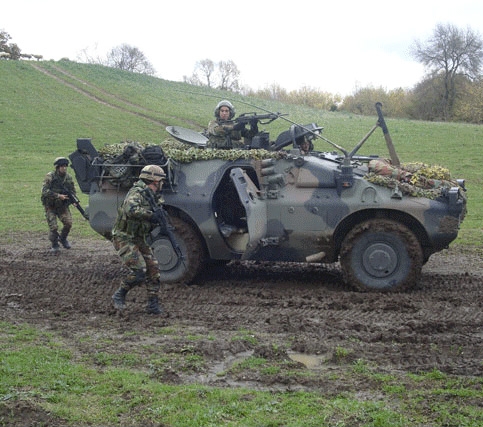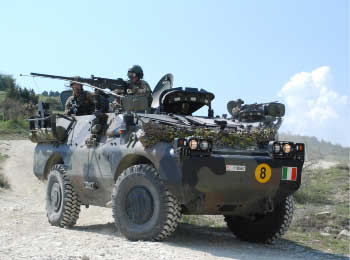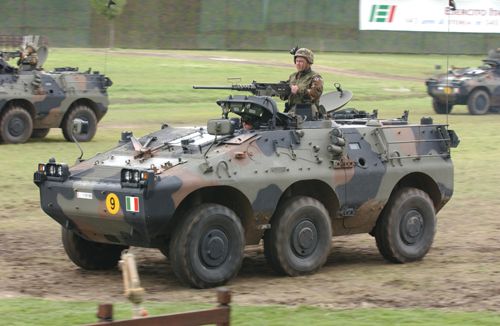Never say again "armored car"
The Italian Puma (to not mismatch with the German IFV) is in effect the lightest in the series of wheeled armored fighting vehicles (AFV) of the Italian Army. The AFV category covers both tracked and wheeled vehicles, and for the latter it all but replaced the old-fashioned "armored car". The term has no relevance today whatsoever, as modern AFVs are conceived from the bottom up as military vehicles and broke all links with the civilian market but some mechanical parts, notably of the engine, saving costs. Such was the Fiat-Iveco Puma, a family of 4x4, 6x6 vehicles designed to complement the new Centauro wheeled tank as Italian Army's Cavalry Regiments and some Infantry regiments as well for reconnaissance.Production by Consorzio Iveco Fiat - Oto Melara.
Iveco (Turin) is Italy's main supplier of powerplants since 1975 and especially a truck, heavy duty, and specialized vehicles manufacturer. It is the parent of a former French-Italian-German entity now the CNH Industrial group and has a presence worldwide (160 countries). It was chosen for the engine, a 4-cylinder turbo-charged diesel which developed 160 hp (118 kW). FIAT on the other hand was contracted for the design and final assembly of the hull as well as Oto Melara for the military equipments and systems.The two vehicles shared a common hull and components but their capacity changed, such as the 6x6 carried six infantrymen, plus the driver and could double as APC while the 4x4 only carried four and is suitable only as a scout. The first prototypes were completed in 1988 and production of five test pre-production vehicles in 1990. However the development process took almost ten years before the certfication was obtained in 1999. The Italian Army ordered 580 Puma vehicles, 250 6x6 and 330 4x4. Schedule for the first batch was mid-2003.
Design of the Puma
Depending on the version the vehicle wieghts between 7 and 8 tons, with a similar (just lenghtened) hull made of a monocoque bended steel plates joined together, sloped on the upper and lower side, but with a central flat section, and protected against small arms fire and shrapnells. Access is granted by the side and rear doors, each being given a pistol port. The engine is at the front, right while the drivet was located at the left with the tranmission. He is given a lifting hatch with three periscopes (and swapping central light intensifier one for night driving), and there is a large central rotatable cupola on the roof for the commander, with five vision blocks. Crew protection includes pressure NBC, automatic fire extinguisher systems, heater and air conditioning.The base supports a mounting for various machine guns, the standard being the 7.62 mm MG light machine gun or 12.7 mm M2HB HMG in alternative, or even a 40 mm automatic grenade launcher, or more recently an OTO-Melara Hitrole remote 12.7 mm weapon station. 12 were ordered and tested, with more to come. The interior is highly modular according to the initial specification asking for a reconnaissance/ATGM carrier/mortar carrier/ambulance/command post vehicle. The most potent ATGM carried is the Raytheon TOW fitted on the roof, and served from the cupola, or MBDA Milan in alternative, or Mistral for AA defence. Two banks of three smoke-grenade launchers are also present on each side.
It can be fitted with a laser warning system as an option. Mobility is helped by a 4x4 or 6x6, all wheels being suspended independently with Messier hydropneumatic struts. The 132 Kw Iveco engine has a turbo-intercooler and is capable of producting 500Nm of torque. It is coupled to a German Renk autmatic 5 speed (4fw/1rv) transmission. The input goes to a front tranfer box and rear differentials. Steering is on the front axle on the 4x4. With a powert-to-weight ratio of 22.8 hp/tonne (for the 4x4), top speed range is about 110 kph (100 for the 6x6). There is a central inflation system for the tyres which are from the run-flat type.
Mobility allows to climb a gradient of 60%, side slope of 30% and ford 1 m of water without preparation. Turning radius is 6 m and the small size of the vehicle made them compatible with all air tranporters and some heavy duty helicopters like the CH54 stallion and Boeing CH47 Chinook. Special equipments includes a self-recovery winch mounted on the left side. Jerrycans and oter equipments can be fitted on the rear back panel on each side of the door and in the steel tubes panniers on each upper rear sides.
Operators
Outside Italy, only a few had been used worldwide, two are used by Argentine to train peacekeepers at Campo de Mayo, two are used by Djibouti, and in 2013 twenty were given to the Libyan government to help against ISIS.The Puma-AFV in action
Eight cavalry and two special force regiments are equipped with the Puma (4x4), while the Infantry regiments are given the 6x6 as the carabinieri, the Lagunari regiment "Serinissima" near Venice, the "Folgore" parachute regiment, 66th air assault, and Alpini regiments. Some have been deployed in peace-keeping operations in Afghanistan in the 2000s.
Puma AFV specifications |
|
| Dimensions | 4.76/5.07 x 2.09 x 1.67 m (15.6/18.7 x 6.8 x 5.4 ft) |
| Total weight, battle ready | 7/8.2 tons (14,000 ibs) |
| Crew | Driver + 3-6 troops dep. version |
| Propulsion | IVECO 4-cyl TD 160 hp (118 kW) p/w 22.8 hp/tonne (4x4) |
| Suspension | Independent Hydraulic Units |
| Top Speed road/off-road | 110/100 km/h (62/60 mph) |
| Operational maximum range | 700 km (435 mi) |
| Armament | Standard MG3 LMG or 12.7 mm M2HB HMG - see notes |
| Armor | Bended steel plates, prot. range 8-13 mm (0.3-0.5 in) |
| Production | 2000-2004: 580 all versions. |
Links about the Puma-AFV
The Puma-AFV on Wikipedia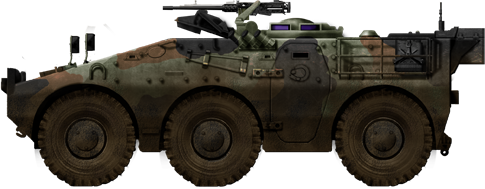
Puma 6x6.
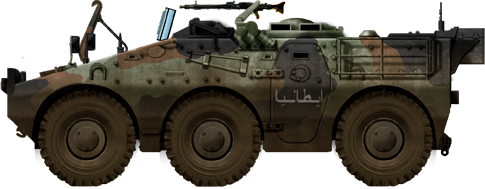
Puma 6x6 donated to the Libyan government against ISIS, 2013
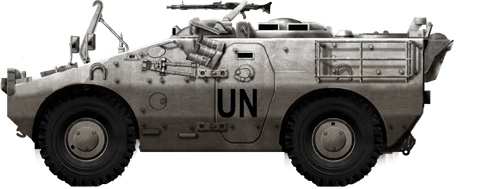
Puma 4x4, in peace-keeping operations, UN.
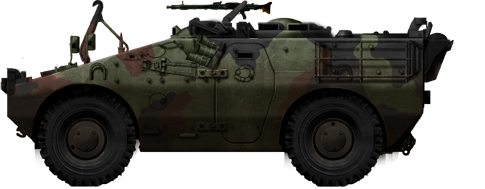
Puma 4x4
Puma-AFV Gallery
